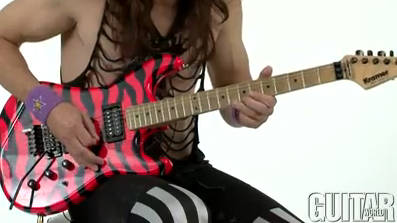Man of Steel with Steel Panther's Satchel: How I Play “If I Was the King”

Hey, kids, I’m back! Did you miss me? Don’t answer that. Here I am, back in the glorious Guitar World studios in Bakersfield, California.
Why am I back? Uh…to teach you how to rock, that’s why! I’m also here to talk about the brand-new Steel Panther album, All You Can Eat, which you are no doubt listening to right now! I came back just so that I could teach you how to play some of the incredible riffs on our new record, and I’d like to start with the song “If I Was the King.”
This song is pretty basic rock and roll in that just about everything in it is based on either the minor pentatonic scale or the blues scale—the biggest scales in rock, right? These scales come in handy.
Don’t just practice the Phrygian and Mixolydian modes—you should be basing everything on the blues and minor pentatonic scales. You might not listen to B.B. King very much, but everything he played is the foundation for all that Testament and Megadeth stuff you listen to, and it’s the foundation of Steel Panther’s music too.
“If I Was the King” can pretty much be summed up as a “heavy-metal shuffle.” FIGURE 1 illustrates the tune’s primary rhythm part, which is built around a steady power-chord climb up the bottom two strings, played alternately against the open low E string, which functions as a pedal tone. The climb is based on the E blues scale (E G A Bb B D) with the inclusion of F#, the major second.
In bar 2, on the upbeat of beat two, I fret the D note on the A string’s fifth fret and, while bending it up a quarter tone by pushing the string away from my palm, I simultaneously pick the open D string, just as Jimmy Page did in Led Zeppelin’s “Whole Lotta Love.” In bar 4, I end with a quick Bb-to-A pull-off on the A string and end the phrase with a low G note. The song’s next riff (FIGURE 2) is simple and based almost entirely on power chords with the occasional single-note riff thrown in.
My guitar solo (FIGURE 3) begins on the four chord, A5, and I start with slow, basic phrases built around A minor pentatonic (A C D E G). Notice how I use gradual bends and wide vibratos to give the solo a bluesy feel. By the end of bar 3, the chord progression works its way back to the one chord, E5, and I do the same with the single-note lick, landing back on E at the end of bar 3.
All the latest guitar news, interviews, lessons, reviews, deals and more, direct to your inbox!
In bar 5, I wait until beat two to come back in and start with a big, Albert King–style bend-and-release, saving the fancy licks for bar 7. There, over C5, I play an arpeggiated figure that can be interpreted as either C6 or Am, as it’s based on the notes of an A minor triad, A C and E (with a D# passing tone thrown in).
This line then shifts to quick, alternating pulloffs to the open G string, followed by a transition to B5 and a lick based on B minor pentatonic (B D E F# A). Overall, it’s a pretty simple solo, but there are some cool twists in there to keep it interesting.


